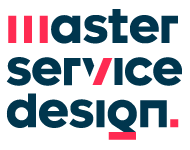We have witnessed an increasing interest in service design in these past years, coming not only from correlated disciplines and contexts, but also from environments where the design language has probably never been spoken.
It seems like service design - the rather new kid of the design industry - has become a hot topic at the moment, overcoming the fields of agencies and consultancies in order to reach companies and individuals who want to discover more about it.
This discipline is evolving and the human-centered approach is going along the way with it. The need of such discipline and approach is not only linked with the development of new services, products or concepts. Nowadays it is largely employed in the management of complex processes and cultural transformations too.
This is the reason why we have witnessed the increasing of its reputation and the birth of more and more in-house service design teams within companies. Anyway as far as the design approach meets the business one, it could be possible that the two will not speak the same language.
To make an example, usually the idea of failure and criticism is not well perceived within corporate environments as it is -on the contrary - within the design field. “Critique is one of the pillars of a successful design team, it walks hand in hand with execution and craft, and it’s evidence of a high-performing team, because it externalizes one of the most important parts of creative execution: trust (“Want To Build A Culture Of Innovation? Master The Design Critique”, Jon Kolko, Fast Company, http://www.jonkolko.com/writingDesignCritique.php ).
According to Rachel Hinman - Product Design Manager at Stitch Fix - there is a need for a real cultural shift for in-house teams in order to bring this trust issue to an institutionalized level.
“If someone says something about your work that is potentially negative, you believe it is coming from a place of positive intent. If you don’t have that trust in the team, it’s really difficult to have a productive critique.”
(Rachel Hinman)
So we could say empathy and trust are not only at the basis of the design process with clients and users but also within the design team. In both cases, we should first define Empathy, what does it really mean? It has become a fuzzy word, sometimes used inappropriately in the design world or during stakeholder meetings.
“As designers, it’s vital that we continue to question our process.”
(“Empathic Design: what is it good for?”, Taylor Higashi )

We should question ourselves not only on the design problems of our briefs, but also on our own methods and processes: do we have enough and useful information to make meaningful user personas? Or are we just following what we are supposed to do to fill blank spaces? At the same time empathy should undergo the same scrutiny we imply in our projects to give them sense.
But this doesn’t mean we have to cut out empathy from our processes, on the contrary: to be able to design great service and reach delightful customer experience, we need to be empathetic being able to control this powerful skill.
“Empathy will get you to see the problems from the users’ perspective, but not the solutions. ”
(“In design, empathy is not enough”, Dan Saffer)
This is a discussion occurs frequently especially in service design blogs and discussions - and for a good reason. It is impossible to design concepts without understanding the other side: what values are directing the emotional drivers of the users taken under consideration? But to bring the project to another level it is important for designers to stay focus in order to find the right way through the solution.
“Service design is about doing, seeing and testing, and not anymore so much about the methods used”
(Birgit Mager)
This isn’t a solved issue, but service design needs more and more field testing, doing, methods validation and processes verification in order to build a strong sense of the practice of the discipline. As highlighted by Birgit Mager during the last SDN conference in Helsinki, there is a need of action and empathic approach less than a rigid discrimination within the methods and tools to use. ( “More empathy and action — the next wave of service design”, Kuundes )

